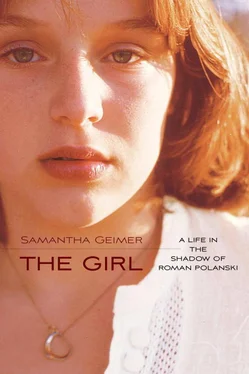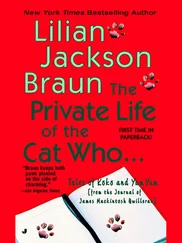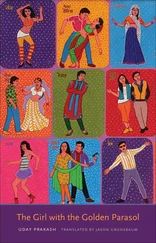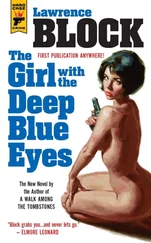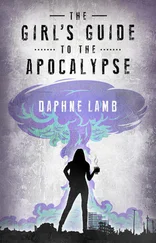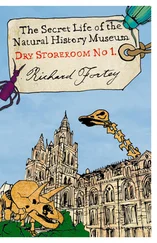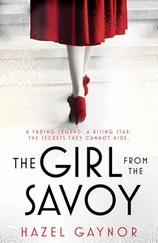Vannatter and Grodin showed him a search warrant, and once inside his hotel suite they found (but ignored) the little yellow case that held the pills. They also found a photo stub from Sav-On Drugs, where Roman had taken film to be developed. The film included the shots of me in Nicholson’s Jacuzzi, naked to the waist.
Lurid tidbits began to leak, slowly but surely, as the press attempted to sensationalize what was already sensational. The Quaalude I’d been given was described as the same drug the actor Freddie Prinze had taken before shooting himself in the head. Anjelica Huston’s testimony provided great fodder, too. In exchange for immunity on her cocaine possession charge, she agreed to testify for the prosecution. But her statement seemed to follow the narrative the defense was trying to create. This is how she described me: “[The girl] didn’t appear to be distressed… she was breathing high in her throat when she came out. She seemed sullen, which I thought was a little rude…. She appeared to be kind of one of those little chicks between—could be any age up to 25… you know, she did not look like a little scared thing….” About Polanski himself, she said, “I have seen him as a man with compassion, not someone who would forcibly hurt another person…. I don’t think he’s a bad man. I think he’s an unhappy man.”
Articles always referred to Roman as the “Polish film director and the widower of murdered actress Sharon Tate.” Polanski was not only at the top of his game, he was also something of a tragic figure in Hollywood. There was a subtext to the early articles: Who was this slutty little girl trying to entrap one of the greatest film directors of all time? Hasn’t poor Roman suffered enough?
The next two weeks were a blur. Polanski posted bail, and there were TV reports showing him being hustled through crowds of cameras and microphones, with a tall, glowering man with bushy sideburns by his side. This was his lawyer, Douglas Dalton. The lawyer shook his head vigorously when questions were shouted at him. I began to notice the channel was often changed as I walked into the living room.
When asked why the photographs seemed so amateurish, Polanski explained to friends that they were intentionally blurred, as though taken on the fly. He was inspired, he said, by the British-born photographer David Hamilton, whose dreamy, grainy, often-nude photos of prepubescent girls—ten, eleven years old—were at that time all the rage. While the British newspaper the Guardian has noted that Hamilton’s photography was “at the forefront of the ‘Is it art or pornography?’ ” debate, that debate was mostly in England and the United States. His work was not at all controversial in France, his home for decades. “It’s like the donkey chasing the carrot all his life,” Hamilton said of his work in an interview. “Girls girls girls. That’s what it’s about. Better than playing football or cricket, I guess.” That morally ambiguous observation might have just as well come from Polanski himself.
Mom was panicking that my name would appear in the news, a concern that was hardly unfounded. While the American press generally resisted printing the names of rape victims, the European press had a different attitude about such things. There, where Roman Polanski was considered a genius and a cultural hero, I was nothing more than a nuisance and an apostate with no rights.
In his autobiography, Polanski would write how the accusation immediately made him the butt of jokes (“Heard the title of Polanski’s next picture? Close Encounters with the Third Grade ”), and box office poison in the United States. “I was a pariah,” he wrote. “ ‘We can’t have a rapist in our agency,’ ” he quoted his former agent Sue Mengers saying. Polanski went on, “Although she later revised this judgment—swung to the other extreme, in fact—her initial attitude was shared by most of Hollywood.”
Polanski’s memory is faulty here—or maybe just convenient for breast-beating. From the beginning there was little outrage among prominent Hollywood figures. But however persecuted he may have felt here, in Europe there was no debate: he was an extremely sympathetic figure, and it was easier to see him as a victim—if not of a malicious setup, then at least of America’s obsession with celebrity and the desire of every aspiring pretty girl to make it, however she could. And Americans—so puritanical, so obsessed with sex and sexual shenanigans!
My mother felt relieved to see him arrested, but I wasn’t so sure, still feeling that I had at least in some way brought all this on myself. If I were clever or if I had put up more of a fight, or if I hadn’t drunk the champagne or taken the Quaalude or… and so on, then I could have figured a way out of Nicholson’s house before things got so crazy. Then I wouldn’t be in this situation—and neither would Polanski.
I knew I hadn’t wanted to have sex with Roman, but did that make it rape? I thought rape had to be violent. When I was told that what he had done was a serious crime because of my age, I was shocked. While I may have been unsure what to call it, I certainly didn’t see it as Polanski himself described it later, in his autobiography: “In all my many premonitions of disaster, one thought had never crossed my mind: that I should be sent to prison, my life and career ruined, for making love.”
Making love? Really? On what planet could what happened ever be considered “making love”?
Still, I was not brutalized. I was not dragged into the woods. I never felt in physical danger, and I never felt “poor me.” At least, not because of being raped.
At the end of March I had to appear before this thing called a grand jury. I didn’t know much about it, but I knew I was going to have to tell the details of what had happened at Jack Nicholson’s house to twenty-three strangers. This was how the courts determined whether a person could be indicted for a crime, and whether a trial could proceed. Was there enough evidence? Was there any evidence? Would I be believed?
I tried not to think about it. I returned to school the week after the rape, and even resumed my acrobatics class, mostly to give the appearance that everything was normal. My name was not yet out, and the news of Polanski’s arrest was not a topic of conversation in the average junior high school. Still, I knew it wouldn’t be long before people figured it out. I had told my friends about the modeling work I had done with a famous movie director, and my friend Terri, of course, knew I had gone off with Roman that day. People were going to put it together soon and realize that I was The Girl.
I wasn’t exactly cut off from the world, but my family made an enormous effort to create a media blackout around me. TVs and radios snapped off, newspapers were hidden; there was lots and lots of shushing.
All that not-thinking-about-it made me nervous. All those concerned, sad eyes pissed me off. I was the surliest everything-is-normal teenager you ever met.
In all honesty, I think I wanted my mother to suffer. Look at the horrible mess she’d gotten us into. If she’d only kept her mouth shut! I didn’t look at her, and if I responded to her at all it was in monosyllables. It kills me now to realize what she was going through at the time: overcome with self-reproach, the feeling she’d failed at her greatest responsibility—protecting me. She also had more practical concerns. Those Ourisman Chevrolet commercials that she flew back east every six months to shoot had been the mainstay of our income for years. If she brought bad publicity to the company, if she were no longer their spokesmodel, we could kiss this sunny Valley life goodbye.
Читать дальше
